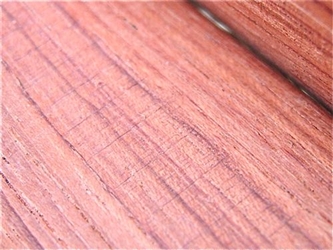 |
Bubinga
Bubinga is a heavy and dense exotic wood from equatorial Africa that delivers a powerful rich tone.
Bubinga is known for its deep brownish-red color and dramatic highlights that resemble rosewood - and is often selected as a less expensive alternative.
The tree is highly resistant to termite attack and thrives in swamps, riverbeds, lakes and marshes where it is culled from large dense logs weighing up to 10 tons each.
Bone Rattling Facts
Bubinga is a luxurious lumber sought by luthiers for harps and guitars. Prominent drum companies such as Tama sell high-end drum kits with plies of Bubinga in the shells.
Cool Facts
Bubinga is often similar in appearance to the mineral tiger eye, and luxury car maker Lexus uses the opulent wood as interior trim in its swankier models.
Bubinga is also known as African Rosewood, although technically it is not from the rosewood family. Interestingly, Bubinga is classified under the genus Guibourtia in the family Fabaceae (Leguminosae): peas and beans.
Bubinga trees produce chalcones - a relative of resveratrol found in the skin of red grapes which is a constituent of red wine - but apparently not in sufficient amounts to explain the French Paradox...an observation that the French suffer a relatively low incidence of coronary heart disease despite a diet rich in saturated fats.
Figures below are approximate (but pretty darn close)
Tonality
Can't Decide Which Bones to Choose?
Check out this handy guide: Bone FAQs
Scroll down for technical Bubinga facts...
|
|
Bubinga Facts
Scientific Name
Guibourtia
Other Names
African Rosewood
Akume
Buvenga
Ebana
Essingang (Cameroon)
Irun nduk
Kevasingo
Kevazingo (Gabon)
Kevazingu
Lianu
Milne
Moubaka
Mouega
Mutenye
Ovang
Oveng
Waka (Zaire)
Waku
Three similar species of Guibourtia provide additional sources of Bubinga. The three species are Guibourtia Demeusei from Nigeria to Congo, Guibourtia Tessmannii from Cameroon, and Guibourtia Pellegriniana from Gabon. A highly figured variety of Bubinga is referred to in the trade as Kevazingo. Another species botanically related to Bubinga is Guibourtia Ehie.
Lookalike Woods
Amazakoue
Amazoue
Anokye
Black Hyedua
Ehie
Hyedua
Hyeduanini
Mozambique
Ovangkol
Shedua
Grain
The very fine grain is straight or interlocking.
Texture
Bubinga has a moderately coarse but even texture.
Luster
Bubinga displays a high luster and offers a nice three-dimensional shimmer under the finish.
Heartwood Color
Reddish Brown with Veining (Pulled Caramel and Chocolate Taffy)
Fresh cut bubinga is pink, vivid red, or red brown with purple streaks or veins. The heartwood can turn yellow or medium brown with exposure and the veining often fades.
Sapwood Color
The sapwood is whitish and clearly demarcated from the heartwood.
Aroma
Freshly milled Bubinga emits a strong unpleasant odor that disappears after the wood is dry. But according to one source, the resin emits a sweet smell described as strawberry Jell-O.
Woodworking
Bubinga works easily with hand or power tools. The wood radiates lovely golden highlights and finishes to a rich luster. It glues well, but lookout for sap pockets that cause gluing or finishing issues.
Environmental Profile
Bubinga grows near lakes, riverbeds, swamps and marshes. Bubinga is not endangered although the status is rated "vulnerable" or "threatened."
Distribution
An exotic wood from Angola, Cameroon, Congo, Equatorial Guinea, Gabon, Ghana, Nigeria and Zaire. Thirteen species occur in equatorial Africa, three in South America.
Tree Data
Bubinga is a large tree that grows to 150 feet (46 m) in height and 6 feet (2 m) in diameter. The heavy dense logs weigh up to 10 tons (9.1 metric tons).
|
|
|